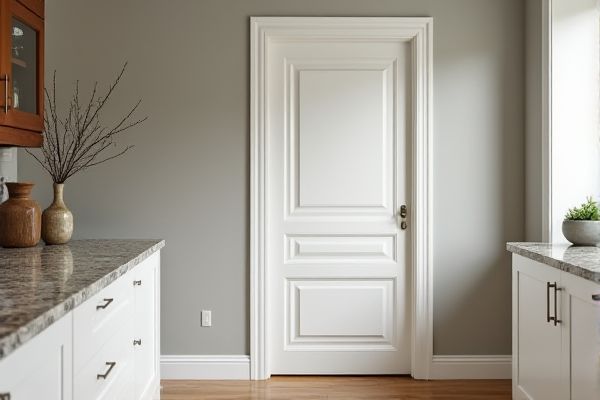
Bi-fold pantry doors save space by folding neatly against the wall, making them ideal for smaller kitchens, while single swing doors offer a more traditional, full-access opening that suits larger areas. Discover which door type best fits Your kitchen layout and design preferences by exploring the rest of this article.
Table of Comparison
| Feature | Bi-Fold Pantry Door | Single Swing Pantry Door |
|---|---|---|
| Space Efficiency | High - folds to save space | Moderate - requires clearance to swing open |
| Installation | Complex - requires track hardware | Simple - standard hinge installation |
| Accessibility | Partial - doors fold but may limit full pantry access | Full - unrestricted pantry opening |
| Durability | Moderate - hinges and tracks may wear over time | High - simpler mechanism, less wear |
| Cost | Higher - due to hardware and installation | Lower - fewer materials and easier setup |
| Maintenance | Requires regular track and hinge cleaning | Minimal - standard door maintenance |
| Aesthetic | Modern look with segmented panels | Classic and versatile design |
Introduction to Pantry Door Options
Bi-fold pantry doors maximize space efficiency by folding neatly against the wall, making them ideal for narrow kitchens or compact areas. Single swing doors offer a traditional and straightforward access with a wide, unobstructed entryway, enhancing the visibility and accessibility of your pantry contents. Choosing the right option depends on your kitchen layout and how you prioritize ease of access versus conserving floor space.
Overview: Bi-Fold vs Single Swing Doors
Bi-fold pantry doors consist of two panels hinged together that fold to the side, saving space and providing wider access to pantry contents compared to single swing doors, which open on a single hinge and require clear floor space. Bi-fold doors are ideal for narrow or confined areas where traditional swing doors might obstruct traffic flow or nearby cabinetry. Single swing doors offer a classic appearance and simpler installation but may limit accessibility in tight spaces due to their full open arc.
Space Efficiency Comparison
Bi-fold pantry doors maximize space efficiency by folding neatly against the wall, allowing full access to pantry contents without requiring clearance for door swing. Single swing doors need a clear radius equal to the door width, reducing usable kitchen floor space and potentially obstructing adjacent cabinetry or appliances. For small kitchens, bi-fold doors offer a compact solution that preserves maneuverability and optimizes storage access.
Installation and Maintenance Requirements
Bi-fold pantry doors require more complex installation involving tracks and hinges, which can take longer and may need professional alignment for smooth operation, while single swing doors offer simpler installation with standard hinges. Maintenance for bi-fold doors includes regular cleaning of track mechanisms and lubrication to prevent sticking, whereas single swing doors demand minimal upkeep mainly focused on hinge lubrication. Your choice will impact installation time and ongoing care, with single swing doors typically offering easier, low-maintenance handling.
Design and Aesthetic Flexibility
Bi-fold pantry doors maximize space efficiency with their compact folding panels, offering a sleek, modern look ideal for smaller kitchens or tight spaces. Single swing doors provide a classic, versatile design that can accommodate various styles, from traditional to contemporary, and allow for broader access to the pantry interior. Choosing between bi-fold and single swing doors depends on the desired balance between space-saving functionality and aesthetic adaptability in kitchen design.
Accessibility and Ease of Use
Bi-fold pantry doors offer enhanced accessibility by folding neatly to the side, maximizing the available opening and allowing full access to pantry contents without obstruction. Single swing doors require clearance space to open outward, which can limit access in tight kitchen layouts and restrict visibility to items inside. The compact folding mechanism of bi-fold doors is particularly advantageous for smaller kitchens, improving ease of use and efficient space management.
Durability and Longevity
Bi-fold pantry doors often experience more wear and tear over time due to multiple hinges and folding mechanisms, potentially reducing their durability compared to single swing doors. Single swing doors, with fewer moving parts and a more robust hinge system, typically offer greater longevity and require less maintenance. Choosing a well-constructed single swing door can enhance your pantry's durability and ensure longer-lasting performance.
Cost Analysis and Budget Considerations
Bi-fold pantry doors typically cost less upfront, ranging from $100 to $300 depending on materials, while single swing doors often start at $150 and can exceed $500 for solid wood models. Installation for bi-fold doors is generally more affordable due to simpler hardware and less framing, whereas single swing doors may require additional structural modifications increasing labor costs. Budget considerations should factor in long-term durability and ease of access, as single swing doors may offer higher resale value despite higher initial expenses.
Pros and Cons Summary
Bi-fold pantry doors save space by folding inward, making them ideal for tight kitchens, but may have hardware that requires maintenance and can limit full access to pantry contents. Single swing doors provide unobstructed pantry access and simpler installation, yet need clearance to open fully, potentially reducing usable kitchen space. Choosing between them depends on kitchen layout priorities and access preferences.
Choosing the Right Pantry Door for Your Home
Bi-fold pantry doors maximize space efficiency by folding neatly to the side, ideal for smaller kitchens where every inch matters. Single swing doors offer a traditional look with wider access but require more clearance, making them better suited for larger pantry areas. Your choice depends on available space and ease of access, balancing functionality with kitchen layout.
 homyna.com
homyna.com